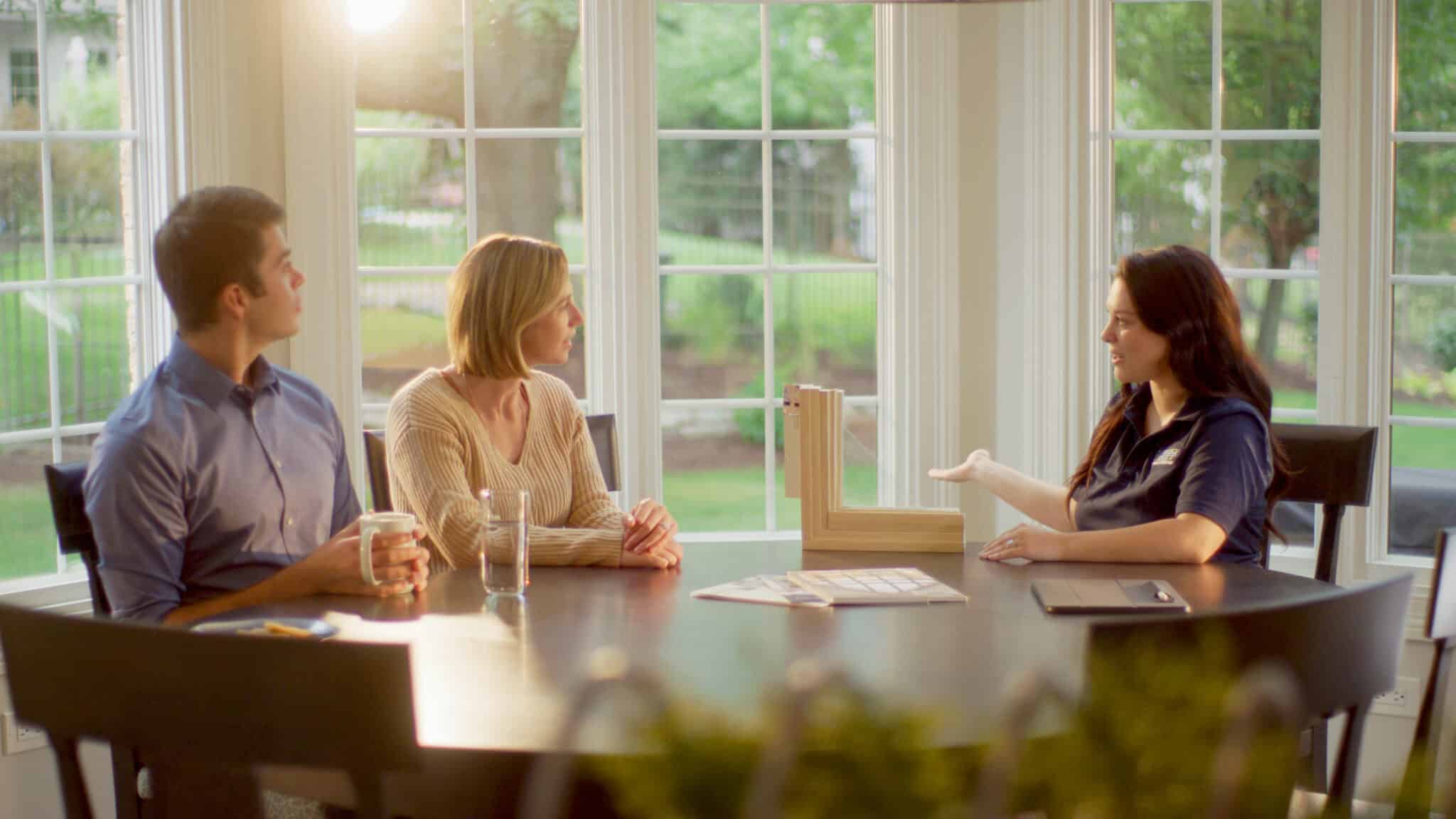Table of Contents
What is a Fiberglass Window?
Fiberglass windows are made from high-temperature melted glass, which is then drawn into fine glass fibers that are woven together. With highly durable features and requiring little maintenance, fiberglass is blended with resins to make it the perfect material for window frames. Fiberglass can be painted, boasts a smooth surface, and can be customized to look like wood. Additionally, fiberglass is thinner than vinyl, which is why many homeowners find it more appealing.
What is a Vinyl Window?
Vinyl windows are made from a certain kind of plastic (polyvinyl chloride) that have gained popularity due to their affordability and low maintenance properties. In addition, vinyl windows can be just as low-maintenance as fiberglass, and you can save yourself some money by installing vinyl windows compared to fiberglass. However, the downside is that vinyl expands in extreme temperatures, and it’s not as eco-friendly or energy efficient as fiberglass.
What Is The Difference In Cost Between Vinyl Windows Vs. Fiberglass Windows?
When comparing the cost of vinyl windows versus fiberglass windows, it’s important to note that prices can vary depending on factors such as window size, style, manufacturer, and geographical location. Here’s a breakdown of the cost difference:
-
Initial Cost
Vinyl windows are generally cheaper compared to fiberglass windows. On average, vinyl windows can range from $300 to $800 per window, while fiberglass windows can range from $500 to $1,500 per window. These estimates are for the window unit itself and do not include installation costs.
When considering the initial cost, vinyl windows appear to be more affordable than fiberglass windows. But we will cover why that’s not actually true later in this article. Vinyl is a synthetic material made primarily from polyvinyl chloride (PVC), which is relatively inexpensive to manufacture. On the other hand, fiberglass windows are made from a composite material composed of glass fibers and resin, which contributes to their higher initial cost. However, it is essential to consider the long-term benefits of fiberglass windows before solely focusing on the upfront expenses.
-
Installation Cost
Installation costs for both vinyl and fiberglass windows will depend on various factors, such as the number of windows, the complexity of the installation, and the labor rates in your area. However, installation costs for vinyl windows are typically lower than fiberglass windows due to the simpler installation process. The installation cost can vary greatly, but a rough estimate for installation could range from $100 to $300 per window.
-
Long-Term Savings
Although fiberglass windows have a higher upfront cost, they offer several long-term benefits that can make them a better investment. Fiberglass windows tend to have a longer lifespan compared to vinyl windows, which may require replacement sooner. This means that over the lifetime of your home, you may end up replacing vinyl windows multiple times, whereas fiberglass windows may last for decades, resulting in potential savings on replacement costs.
One of the key advantages of fiberglass windows over vinyl windows is their exceptional durability and longevity. While vinyl windows may offer a satisfactory lifespan of around 20 to 30 years, fiberglass windows have a significantly longer lifespan, typically lasting for 40 years or more. This longevity can be attributed to the inherent strength and stability of fiberglass, which resists warping, cracking, and deterioration over time. And with harsh Chicago weather, warping and cracking could happen a lot sooner with vinyl windows. By choosing fiberglass windows, homeowners can save on future replacement costs, making them a better long-term investment.
-
Energy Efficiency
Fiberglass windows generally have better energy efficiency properties compared to vinyl windows. There is a big benefit with fiberglass and that it does not expand or contract, and therefore the windows stay snug and tight, which helps enhance energy efficiency. The improved insulation capabilities of fiberglass windows can help reduce heating and cooling costs over time. While it’s challenging to put an exact price tag on these savings, the energy efficiency of fiberglass windows can contribute to significant long-term savings on utility bills.
Energy efficiency is an important factor to consider when evaluating the long-term cost-effectiveness of windows. Fiberglass windows excel in this aspect, surpassing vinyl windows in terms of energy performance. Fiberglass has excellent insulating properties, providing superior thermal efficiency and reducing heat transfer. This means that fiberglass windows can effectively keep your home cool in the summer and warm in the winter, reducing your reliance on heating and cooling systems. By minimizing energy consumption, fiberglass windows can lead to substantial long-term savings on utility bills, offsetting their initial higher cost.
-
Maintenance and Repairs
Another aspect to consider is the maintenance and repair requirements of different window materials. Vinyl windows are often touted as low-maintenance due to their resistance to rot, peeling, and fading. However, they can become prone to warping, especially in extreme weather conditions. Fiberglass windows, on the other hand, require minimal maintenance and are highly resistant to warping, rotting, and expanding or contracting due to temperature fluctuations. Additionally, if repairs are ever needed, fiberglass windows can often be repaired rather than requiring a complete replacement, adding to their cost-effectiveness over time.
Vinyl windows are often advertised as low-maintenance, requiring minimal upkeep. On the other hand, fiberglass windows are also low-maintenance but are more resistant to warping, cracking, and deterioration over time. This durability can result in potential cost savings on repairs or replacements down the line.
-
Aesthetics and Customization
While both vinyl and fiberglass windows offer a range of design options, fiberglass windows provide more flexibility for customization. Fiberglass can be easily painted, allowing homeowners to change the color of their windows to match their evolving interior or exterior aesthetics. Plus, with narrow frames, fiberglass offers bigger views. This versatility makes fiberglass windows a desirable choice for those seeking long-term adaptability and personalized style.
It’s important to consider the long-term benefits and cost implications when choosing between vinyl and fiberglass windows. While vinyl windows have a lower initial cost, fiberglass windows offer superior durability, energy efficiency, and potential long-term savings. Ultimately, the decision should be based on your specific needs, budget, and the overall value you seek for your home.
Want to understand more about the costs and benefits between vinyl and fiberglass? Check out this video from Amer Khan, Design & Energy Expert. He explains the cost of fiberglass windows best.
Comments are closed.



